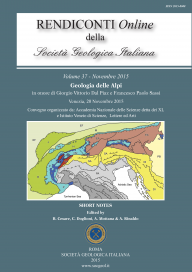
A comet in Alpine style: how standard techniques for the reconstruction of geological structures, pioneered by Émile Argand, can help unravelling the evolution of the Solar System
Matteo Massironi (a,b) & Andrea Bistacchi (c)
(a) Department of Geosciences, Padova University, via Gradenigo 6, 35131 Padova, Italy. Corresponding email: matteo.massironi@unipd.it
(b) CISAS, University of Padova, via Venezia 15, 35131 Padova, Italy.
(c) Department of Earth and Environmental Sciences, Università degli Studi di Milano Bicocca, Piazza della Scienza 4, 20126 Milano, Italy.
DOI: https://doi.org/10.3301/ROL.2015.170
Volume: 37/2015
Pages: 34-36
Abstract
Following the steps of Émile Argand, who in 1911 provided the first 3D geological reconstruction of the Penninic nappe stack in the western Alps, it is nowadays possible with software-assisted implementations of the same geo-structural concepts to retrieve rigorous 3D geological models for major engineering projects, such as transalpine tunnels. Among the others, the geo-structural analysis realized for the Brenner Basis tunnel project represents a noticeable example of the application of such methodologies, since it was possible to retrieve reliable 3D models of the structural architectures of key sectors of the North Eastern Alps.
When the space probe Rosetta inserted into orbit around the bilobed comet 67P/Churyumov-Gerasimenko (67P/CG), the same methodologies used to analyze the complex structural framework of the poly-deformed Alpine nappe-stack have soon revealed essential to understand the inner structure of the comet nucleus. The final result, showing that the two lobes are indeed the expression of two independent objects characterized by a thick onion-like stratification, provides a clear evidence of a primordial and still unknown sedimentary process dated back to the origin of our Solar System. The astronomical implications are not less relevant since the 67P/CG inner structure demonstrates how primordial bodies such as comets could have merged in the proto-planetary disk through low velocity impacts (a few meters per second) and should have unexpectedly escaped any catastrophic collision during the entire evolution of the Solar System.
Keywords
Get Full Text